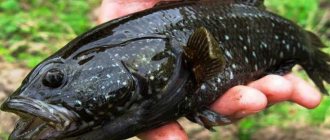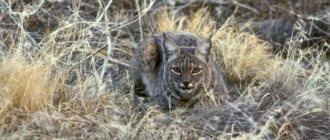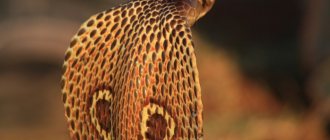- Wild animals
- >>
- Mammals
Not everyone is familiar with such a graceful and stunningly beautiful feline as Margay , she looks like a toy leopard, because... small in size. This wild mustachioed predator can captivate with her magnificent fur coat and bottomless, hypnotizing eyes. Let's analyze all the most important things related to the life of this exotic cat, describing not only its appearance, but also its habits, food preferences, favorite places to live and the cat's independent disposition.
Description
The Margay is a beautiful, spotted, small cat, slightly larger than a large domestic cat. The coat color varies from reddish-yellow to gray-brown. The animal's body has dark spots and rosettes with a brown center. The head, neck and throat are covered with black lines, and the backs of the ears are black with a white spot in the center. The belly is whitish, and the long and bushy tail is marked with 10-12 dark rings. A cat's fur is relatively thick and soft. The species has many individual variations in body patterns. Males and females are similar in size and appearance.
The average body length, including the head, ranges from 463 to 790 mm, the tail length is 331 – 510 mm. Margay weighs from 2.6 to 3.9 kg.
Margay cats are often confused with their close relatives - ocelots and oncillas. The article “Tiger cats: ocelot, margay, oncilla, and their comparative characteristics” highlights the main differences between these 3 species.
The following subspecies are currently recognized:
- L. wiedii wiedii, eastern and central Brazil, Paraguay, Uruguay, northern Argentina;
- L. wiedii amazonicus, western Brazil, Peru, Colombia and Venezuela;
- L. wiedii boliviae, Bolivia;
- L. wiedii cooperi, northern Mexico;
- L. wiedii glauculus, central Mexico;
- L. wiedii nicaraguae, Honduras, Nicaragua, Costa Rica;
- L. wiedii oaxacensis, southern Mexico;
- L. wiedii pirrensis, Panama, Colombia, Ecuador, Peru;
- L. wiedii salvinius, Chiapas, Guatemala, El Salvador;
- L. wiedii yucatanicus, Yucatan.
Diet
To identify the food preferences of this secretive and cautious predator, scientists had to examine the contents of animal stomachs and fecal matter. It turned out that the basis of Margay’s diet consists of:
- monkey;
- birds;
- lizards;
- reptiles;
- sloths;
- tree frogs;
- proteins;
- opossums;
- reed rats;
- packs Cuniculus paca – weighing 5-12 kg;
- porcupines;
- Guinea pigs;
- eggs from bird nests;
- insects;
- grass, fruits to improve the functioning of the gastrointestinal tract.
Analyzing the list of potential victims, it is easy to notice that although the animal prefers to hunt in trees, it also does it well on the ground.
Brave and dexterous Margai are even able to fight with a medium-sized primate, for example, a tamarin, and these are very strong creatures.
When hunting at night and during the day, the predator prefers to take a wait-and-see position, attacking precisely at the moment when the prey does not expect it. The beast can pursue prey for a short time, but usually a lightning-fast throw is fatal.
The hunt usually begins at midnight and ends just before dawn. The Brazilian species are distinguished by the fact that they can pursue prey at any time of the day.
The average amount of food per day for an adult is about half a kilogram.
Habitat
Long-tailed cats are limited to forest habitats, and are closely associated with dense lowland forests below 1500 meters above sea level. They have been found in tropical moist evergreen and deciduous forests, montane and cloud forests, wet, swampy savannas, and sometimes in coffee and cocoa plantations with large trees. Mexico is the northernmost limit of their distribution, which ranges down through Central and South America to northern Argentina.
Margay cats do not tolerate altered habitats, and refuse to cross open areas without vegetation. They avoid converted landscapes except for dense plantations of coffee, cocoa, eucalyptus and pine. Thanks to a study conducted in northern Argentina, lower densities of margay cats were found in parks and other protected areas, possibly due to high ocelot numbers.
Natural enemies of Margai
Photo: Margay cat
Almost nothing is known about the enemies of margays found in the wild natural environment. This is due to the fact that these cats lead a very secretive and solitary life, being in dense impenetrable jungles and high on tree branches. Here we can only assume that larger predatory animals are capable of attacking these amazing cats. There is no specific data on this matter.
It is known that, sensing danger, the margay immediately jumps onto a tree, can hide in the dense crown or take a defensive stance if a fight is inevitable. Most often, inexperienced young animals and very small defenseless kittens suffer, which are most vulnerable at those moments when their mother goes hunting. There is disappointing data that only 50 percent of babies survive to one year.
Scientists have not been able to find out who the specific enemy of the margay is in wild natural conditions, but there is one insidious ill-wisher who has led to the fact that there are very few of these cats left, the name of this malicious enemy is man. It’s sad to realize, but people are the main exterminators of these beautiful and graceful animals, who suffer because of their valuable and attractive skin.
Reproduction
Long-tailed cats are solitary animals, with the exception of females with kittens. After a gestation period of approximately 76 – 85 days, one kitten is born, (rarely two), once a year. Unlike other types of wild cats, margas have only one pair of mammary glands, and estrus can occur spontaneously. Their birth weight is 84-170 grams and their eyes open at around two weeks of age. The fur of juveniles is darker than that of adults and evenly covered with dark spots, and their paws are dark gray. Weaning from mother's milk occurs at about two months of age, and sexual maturity occurs at two years.
Population and species status
Photo: What margay looks like
Currently, the population of margays has greatly decreased. It's sad to realize this, but felines are facing extinction. This is a deplorable situation throughout almost the entire habitat of this unusual cat. This is due to barbaric human actions aimed only at pleasing people.
First of all, the extermination of margays due to their expensive and beautiful fur greatly reduced the cat population. For many years, cats were relentlessly hunted in order to obtain their silky patterned coat. There is evidence that in the seventies of the last century, about thirty thousand cat skins were sold on the international market annually, which led to a strong and sharp decline in the margay population. Now the Washington Convention is in force, which monitors compliance with the ban on hunting and all trade in margay fur. Despite the strict ban, cases of poaching still occur, which greatly worries environmental organizations.
Man has reduced the population of margays, not only by hunting them, but also by carrying out other economic activities. Animals are greatly threatened by human intervention in their natural habitats, deforestation, degradation of permanent habitats and environmental pollution in general. Margai need special protective measures in order not to completely disappear from our planet.
Behavior
Long-tailed cats primarily live in trees, but they hunt and roam on land. They are agile and acrobatic climbers, thanks to their wide feet, flexible toes and large claws, while their long tail provides balance. Additionally, the hind legs can rotate inward 180°, allowing cats to grip a tree trunk, making them the only cat capable of climbing upside down in vertical trees. Their exceptionally long, heavy tails help balance them when moving from tree to tree. Also, long-tailed cats are able to hang on branches using their hind legs, and use their front legs to handle some object. Typically, they are active at night and rest in trees during the day.
What does margay eat?
Photo: Margay cat
Since the long-tailed cat is a predator, its menu consists mainly of dishes of animal origin. The dimensions of margays are small, so their victims are most often small mammals that also live in tree branches.
So, the Margi cat is not averse to a snack:
- rats;
- proteins;
- possums;
- small birds;
- bird eggs and defenseless chicks.
Yes, a wild cat sometimes commits robbery, destroying bird nests, from where it steals eggs and small chicks. If there is nothing tastier, then the margay will eat a lizard, a frog, and even various large insects. Feline predators can also attack monkeys, porcupines, and sloths. Zoological scientists have found that margays need about half a kilogram of food every day for a normal and active life.
For the most part, mustaches hunt all night long, returning to their lair only early in the morning. The hunting process can take place not only in the tree crown, but also on the hard earth's surface. Margai love to make ambushes, attack suddenly and pursue their fleeing dinner.
Interesting fact: Surprisingly, the cat’s menu also includes plant food, which consists of various fruits, berries, grass and young shoots. Of course, in percentage terms it is significantly inferior to animal food, but it is still present in the diet.
Threats
The population status of long-tailed cats is difficult to determine due to poor publicity. Apparently the cat population has dropped significantly. Several decades ago, this species was one of the most heavily exploited Latin American cats in the international fur trade, especially after concerns were raised about the high level of exploitation of ocelots. The small size of Margay cats means that at least 15 pelts must be used to make one coat, and approximately 14,000 of the species were traded annually between 1976 and 1984. Even though long-tailed cats have less valuable fur than ocelots, they can get caught in ocelot traps. The introduction of legal protections against illegal hunting is an ongoing issue in some cat areas. The main threat to margi cats is considered to be habitat destruction as a result of deforestation, land use for agriculture, and road construction. The arboreal lifestyle, combined with its naturally low numbers and low reproductive rate, makes the margay cat particularly vulnerable.
Life of a long-tailed cat in captivity
Margai is a wild beast, although he has a cute appearance. Such animals have clearly developed appropriate behavior, so they are not adapted to home life. Any small animal in the house will definitely become margay’s prey. Even a small dog can suffer from the claws and teeth of a wild cat. Therefore, representatives of the species living in captivity can be found in zoos.
However, you can legally buy a long-tailed cat and try to tame it. Kittens are sold in specialized nurseries. The price for an exotic kitten can exceed $20,000. It is known that if taken at an early age and well-bred, a margay will not attack people (although owners of other wild cats are not immune from this).
I have seen many advertisements on the Internet for the sale of long-tailed cat kittens. The price in the advertisements ranged from $2,700 and above. The authors of the advertisements explained that the low price was due to the condition of the kittens. Allegedly, the animals had health problems, including after gunshot wounds. At the same time, the sellers assured that the kittens had all the necessary documents. The interesting thing is that in the comments under the ad there were no reviews from those people who had already bought kittens. I think that this is an illegal sale, since zoos and nurseries will not give such advertisements on behalf of private individuals.
To properly raise a margay, it must be adopted at an early age.
Features of caring for a predator
Of course, the main requirements for keeping a wild cat are safety measures. All windows and doors must be protected with metal mesh. This will protect not only the owner of the house and his children, but also the cat itself. The animal may leave home and not return. If we are talking about cool regions of Russia, then the animal faces almost one hundred percent death from hypothermia in the first autumn. If we are talking about a relatively warm and humid climate, then in the courtyard of the house you can install a special enclosure covered with a high mesh. However, even in such an enclosure you need a warm house for the cat. In the absence of a house, the cat will have to be brought home at night.
You need to install branches and trees in the enclosure so that the cat can occupy a position at a certain height. But bare trunks and logs are only suitable for games and entertainment. For the full development of a wild kitten, foliage and green spaces are needed. The cat should feel like he is in nature.
If margay is raised correctly, he can go into your arms
Such a cat needs to be fed meat with small bones (beef, chicken, feed mice and offal). Such food is very similar to prey that a cat could catch in the wild. In addition, the cat needs to be given vitamins and special supplements. Usually people who dare to purchase such an exotic pet communicate closely with veterinarians. Only special skills and knowledge of animal medicine will allow you to raise and educate a wonderful cat.
If a person does everything correctly, the cat will eventually allow itself to be picked up and stroked. However, a wild cat will not be able to sit on your lap for hours. Two or three minutes - and the animal’s patience will run out.
Video: Margay named Maya eats meat
There have been cases when long-tailed cats lived their entire lives next to humans. True, the behavior of such an animal is more similar to the behavior of a dog. A tamed margay fussily stomps on its owner’s chest and licks his face. I heard that wild cats can even protect their owner and growl at offenders if there is any threat from them.
Video: affectionate margay licks people
Scientific classification
- Kingdom: Animalia (animals)
- Phylum: Chordata
- Class: Mammalia (mammals)
- Order: Carnivora (predatory)
- Family: Felidae (felines)
- Genus: Leopardus (South American cats)
- Species: Leopardus wiedii (margay, long-tailed cat)
The specific name "wiedii" was given in honor of the German naturalist Prince Maximilian Wied-Neuwied, from whose collection the species was described. The name "margay" was first used by the naturalist Buffon. It comes from the word "rnaragao" used by a traveler to describe a cat. This word, in turn, probably comes from the Guaranese word "mbaracaya", which means "wild cat".
Did you know?
- Margay fossils have been found in Florida and Georgia in geological formations formed during the Pleistocene, suggesting that the animal inhabited a much larger area than today.
- Long-tailed cats can jump up to almost six meters in height and up to nine meters horizontally.
- Margays have a high kitten mortality rate (about 50%) and also have problems with reproduction in captivity, so introducing new populations into the wild to diversify the gene pool is very difficult.
- An interspecific hybrid between the Margay and a domestic cat gave rise to a new breed: the Bristol.
- In captivity, margays can live 20 years. The causes of their mortality are usually diseases of the respiratory system (23%, especially pneumonia), infectious diseases and disorders of the digestive system (15.4% each), as well as disorders of the nervous and genitourinary systems and parasites (7.7% each).
Rules of education
Margai are highly trainable and trainable. However, when communicating with representatives of this breed, it is important to take into account their independence and predatory instincts. You can gain the favor and respect of an animal by teaching it to hand-feed; it is best to do this at a young age.
It is strictly forbidden to use loud screams or physical punishment in education.
If necessary, it is better to wean a long-tailed cat from something, using a spray bottle and other repellent objects, in combination with the word “no,” spoken in a calm and confident voice.
Long-tailed cats (margai or margi) are very cute and smart. friendly and easy to train. Of course, in captivity it is difficult to create optimal living conditions for such a pet, but if the basic rules are followed, the margay feels great, becomes attached to humans and even becomes tame.











